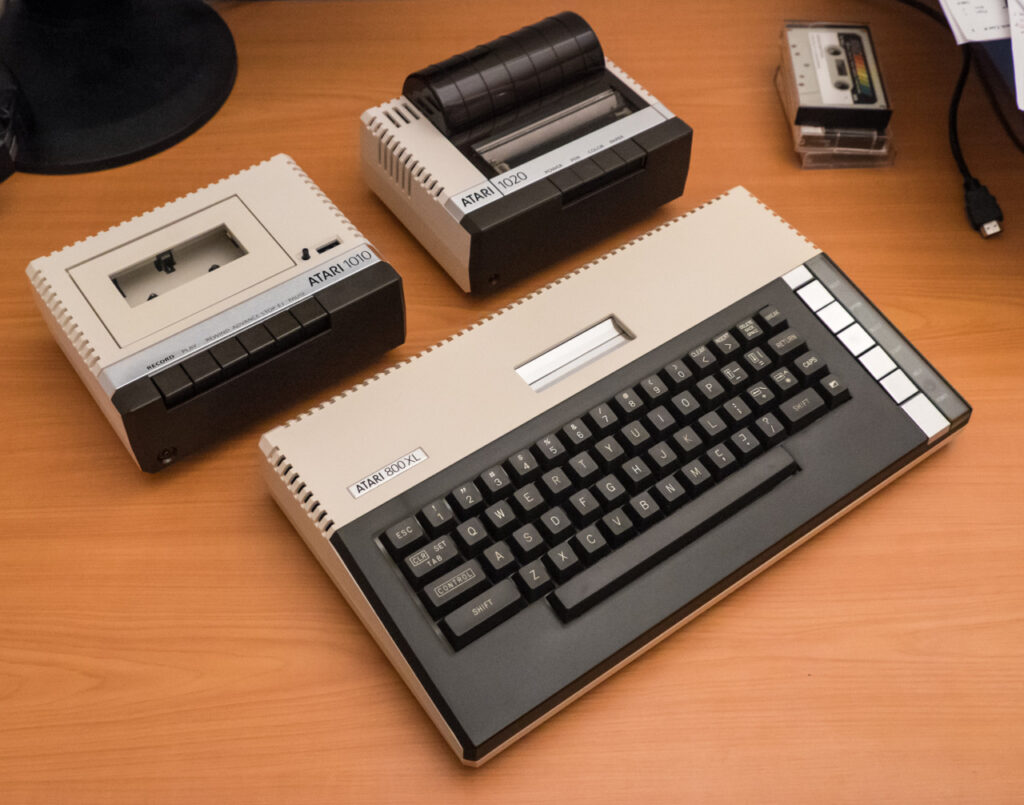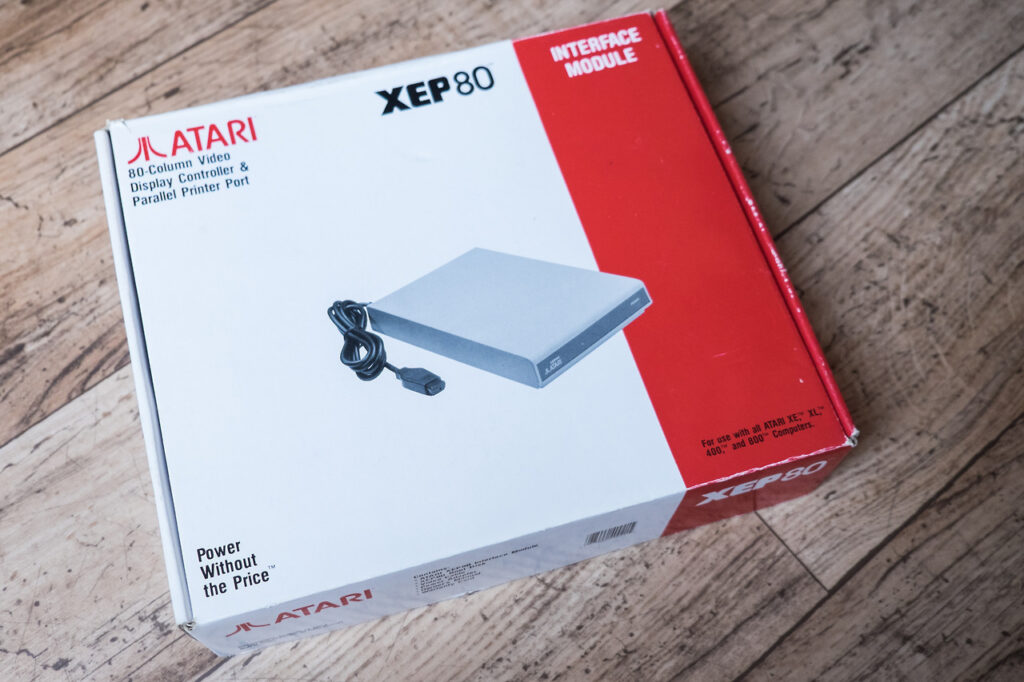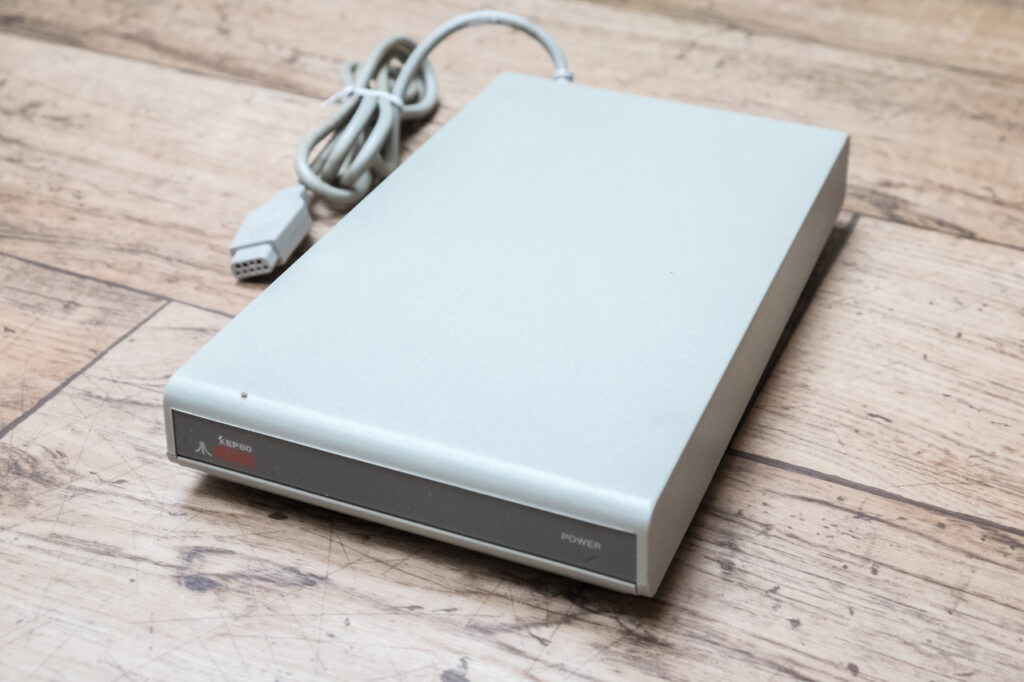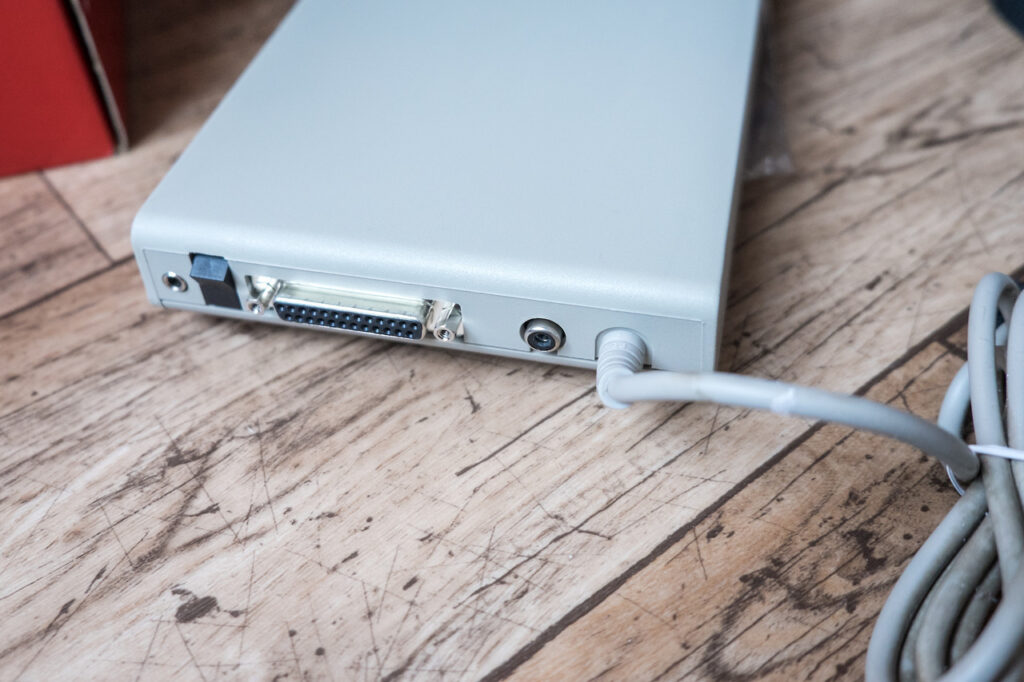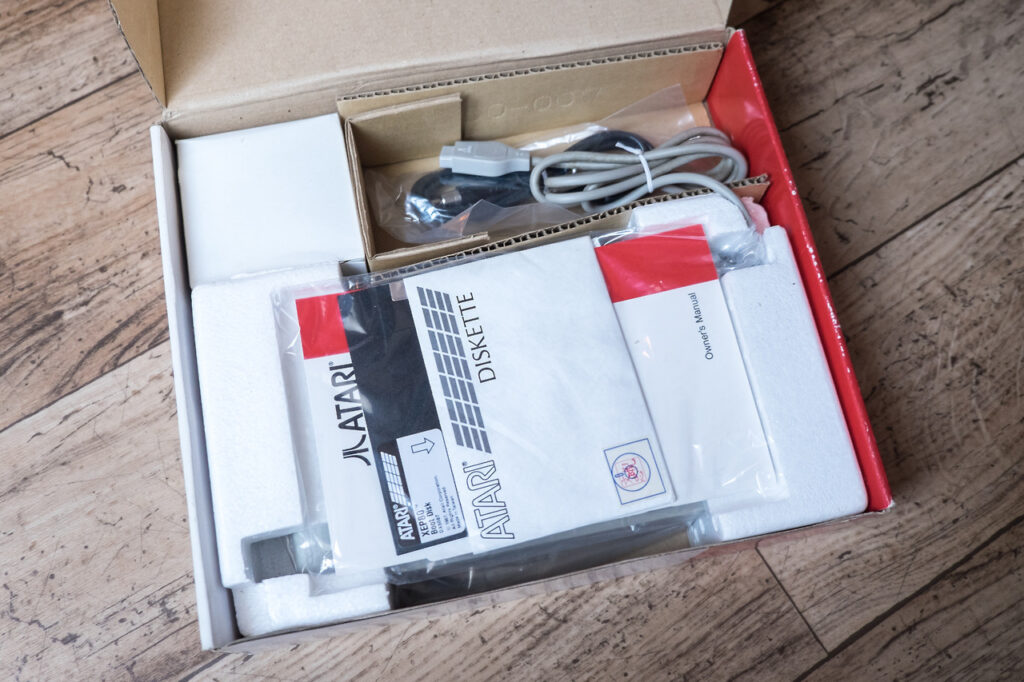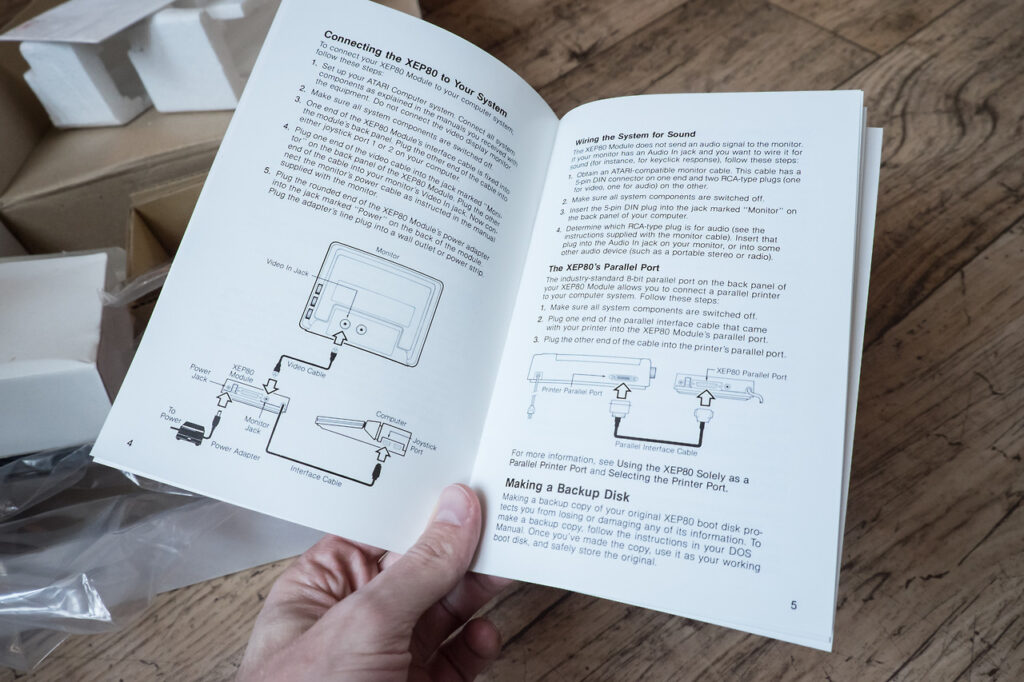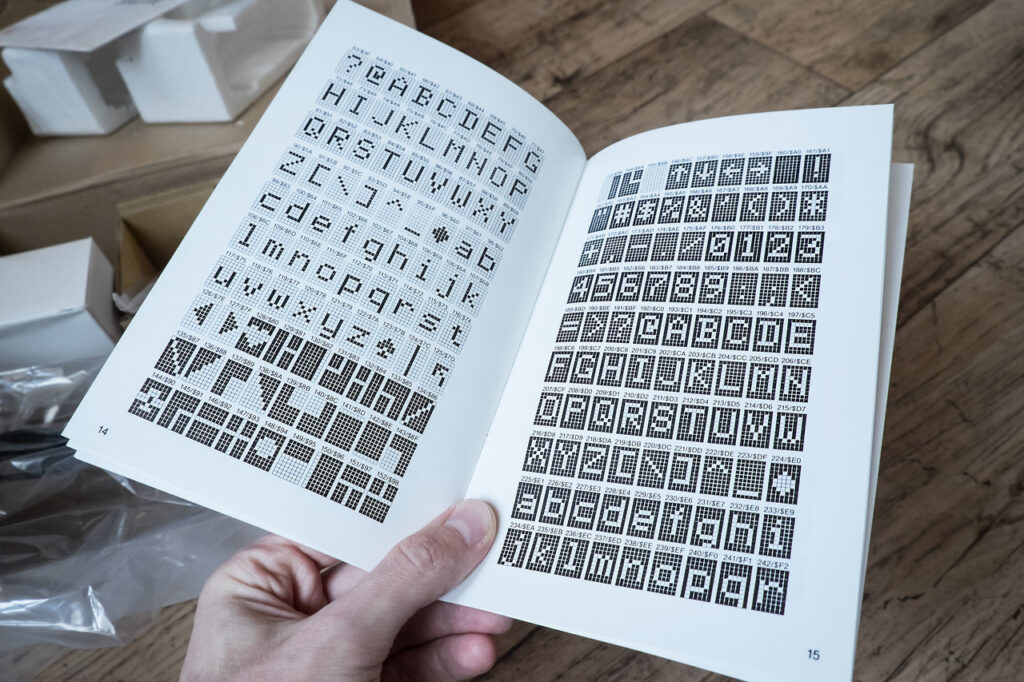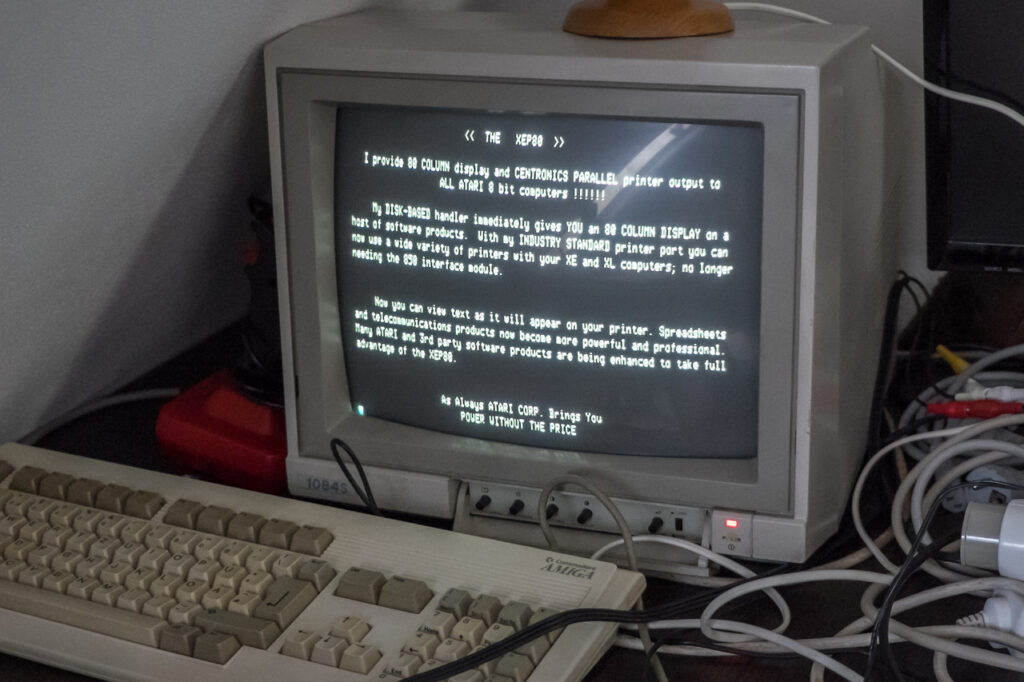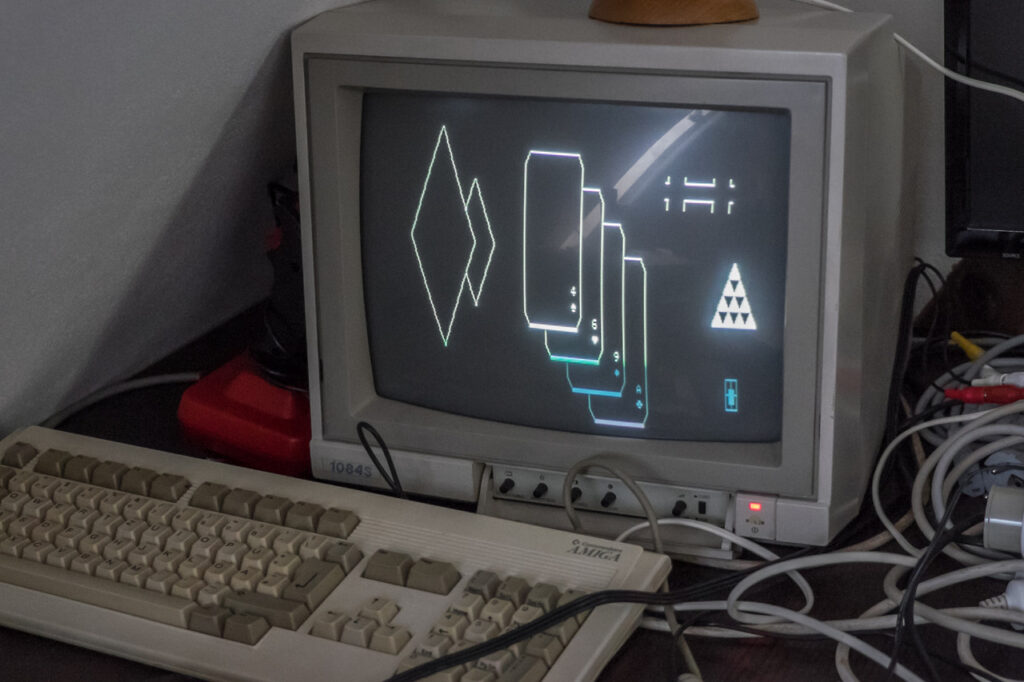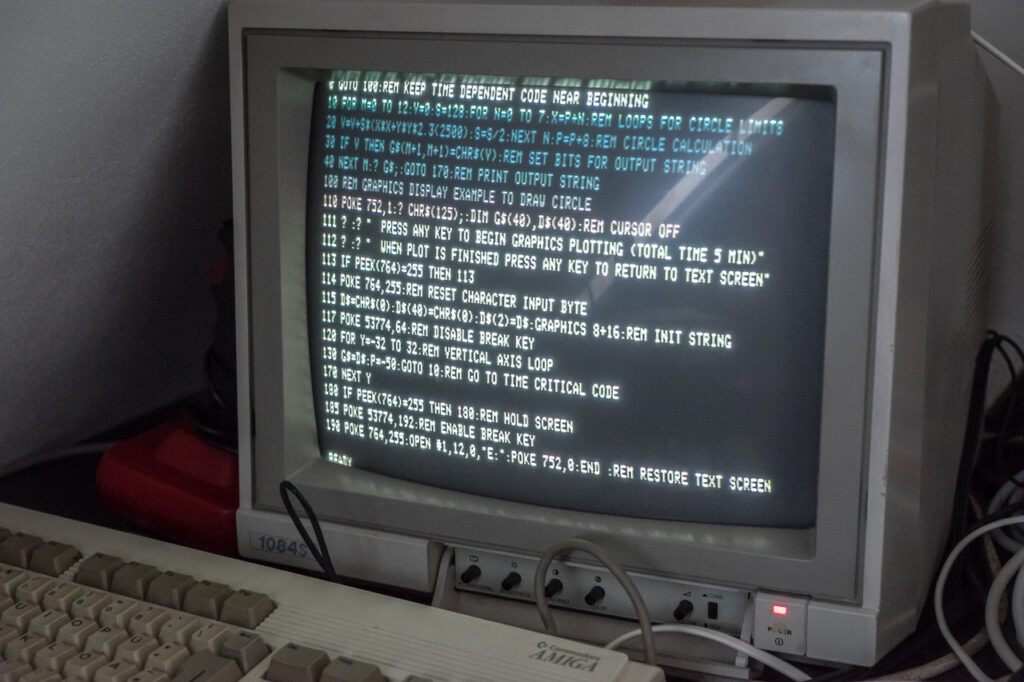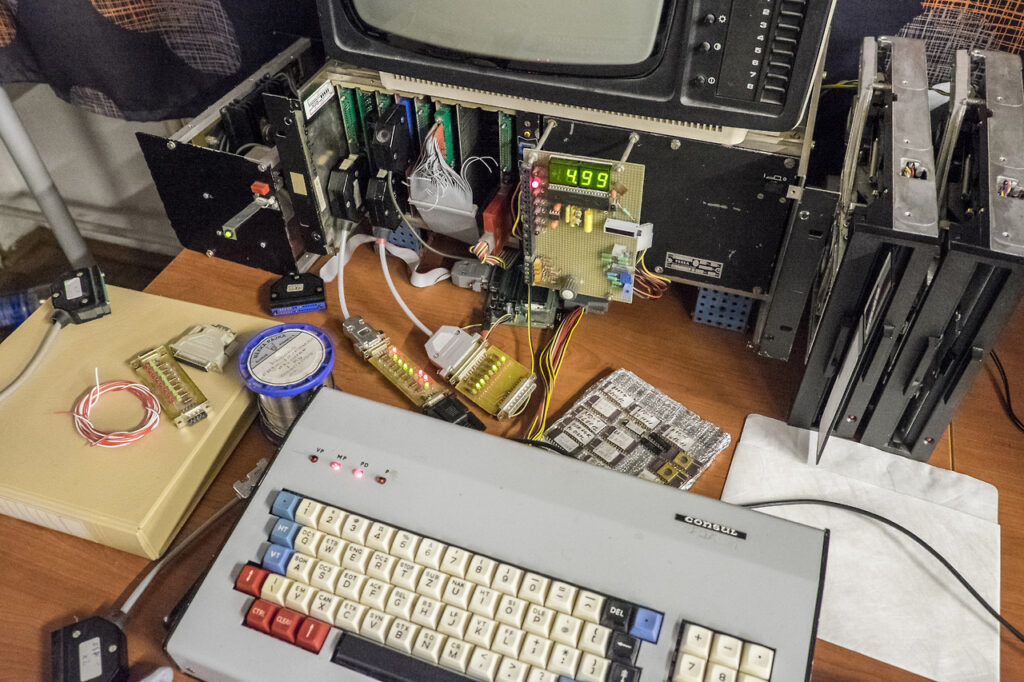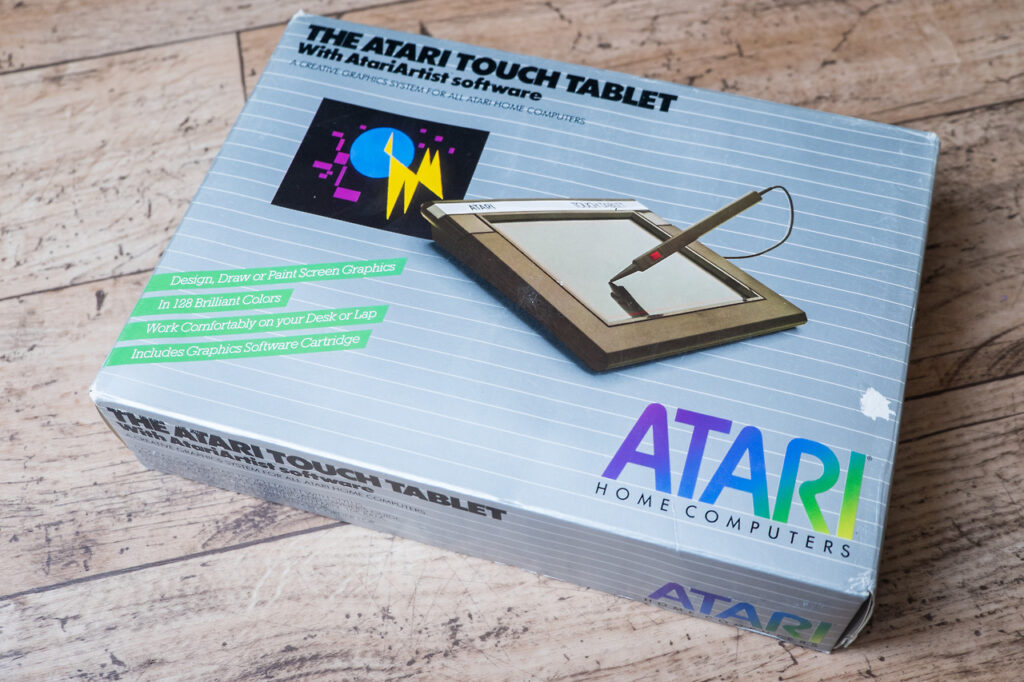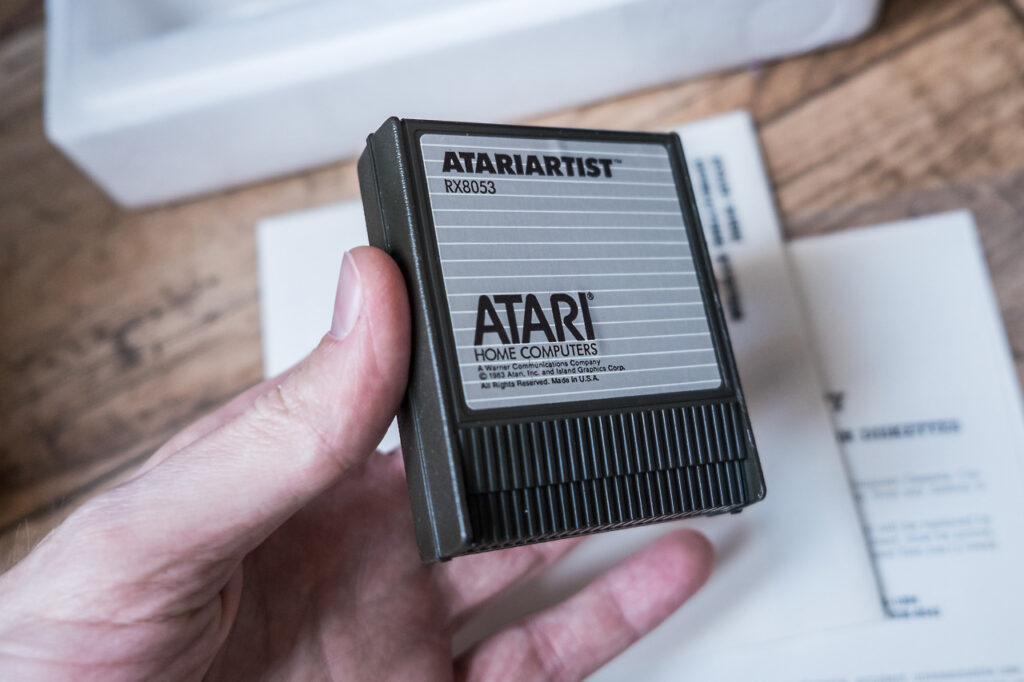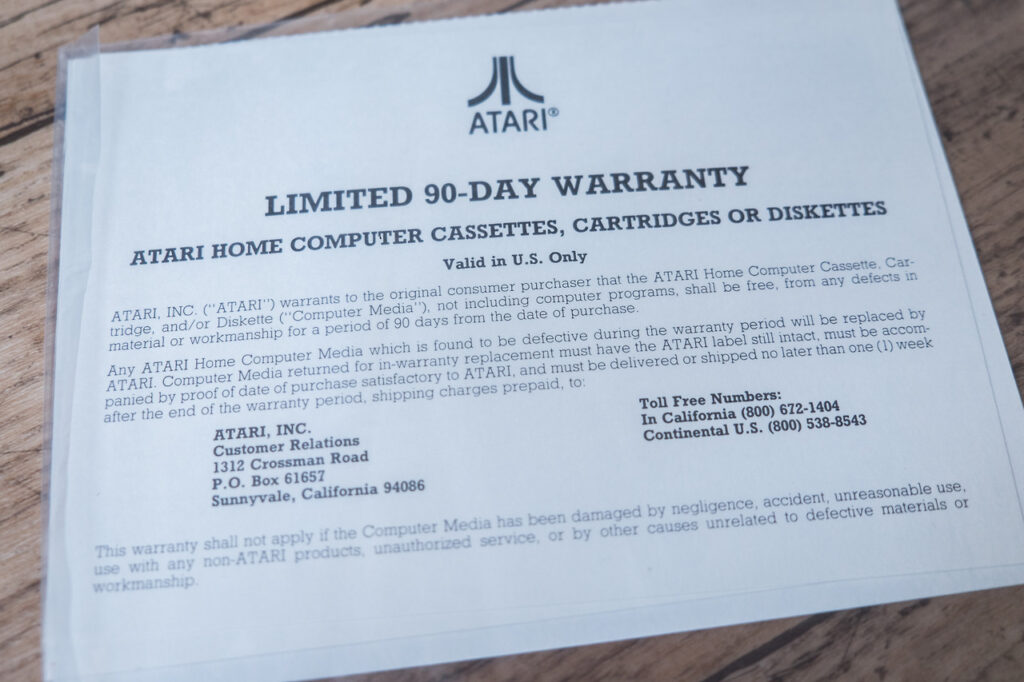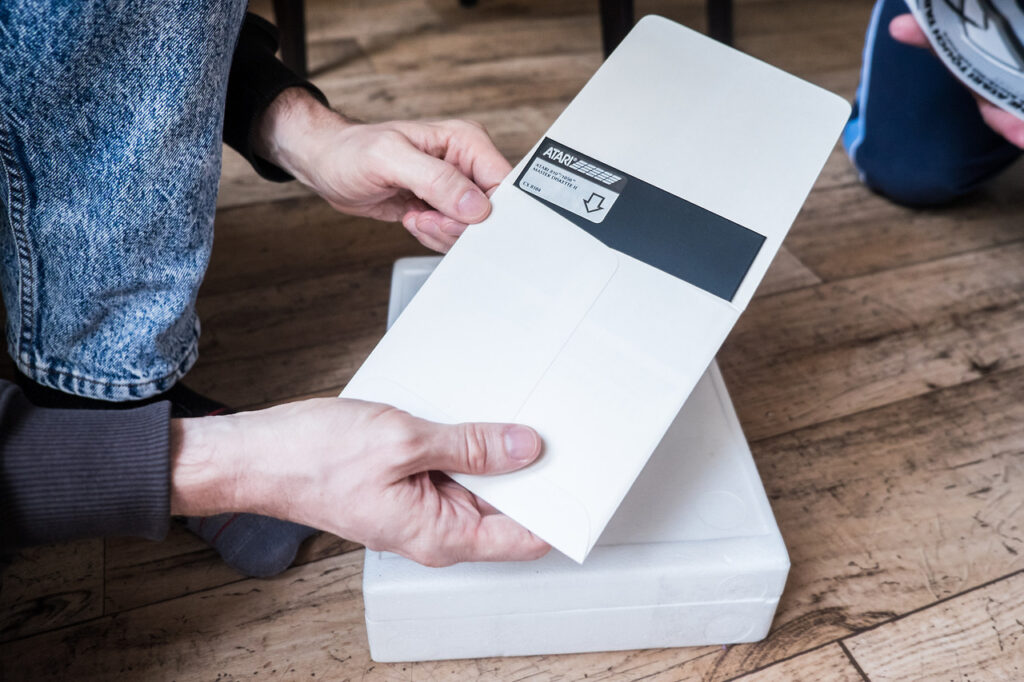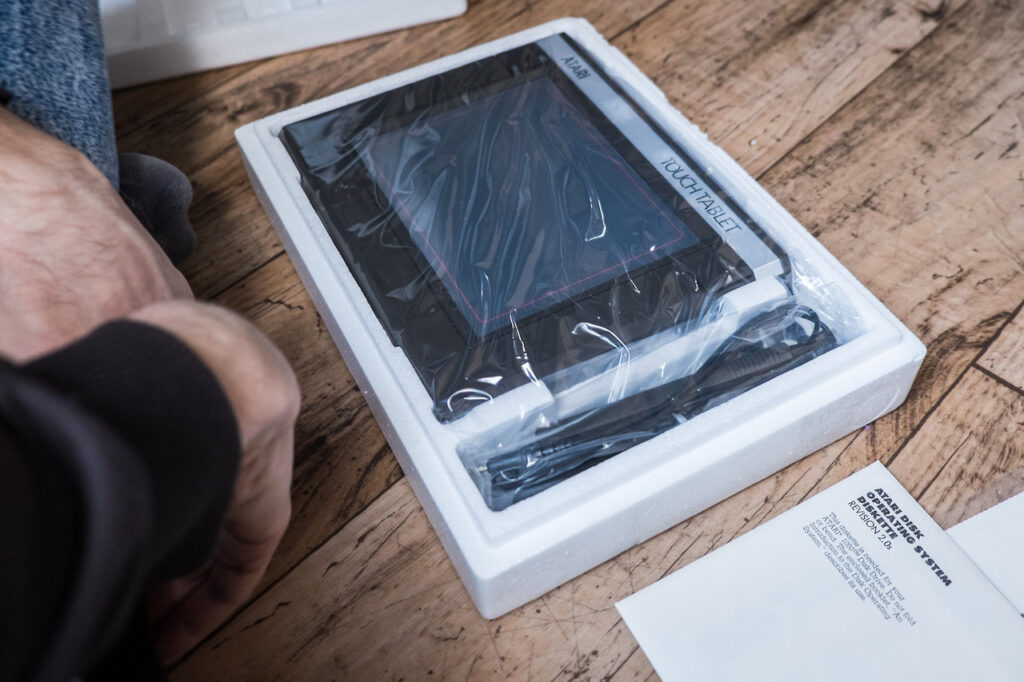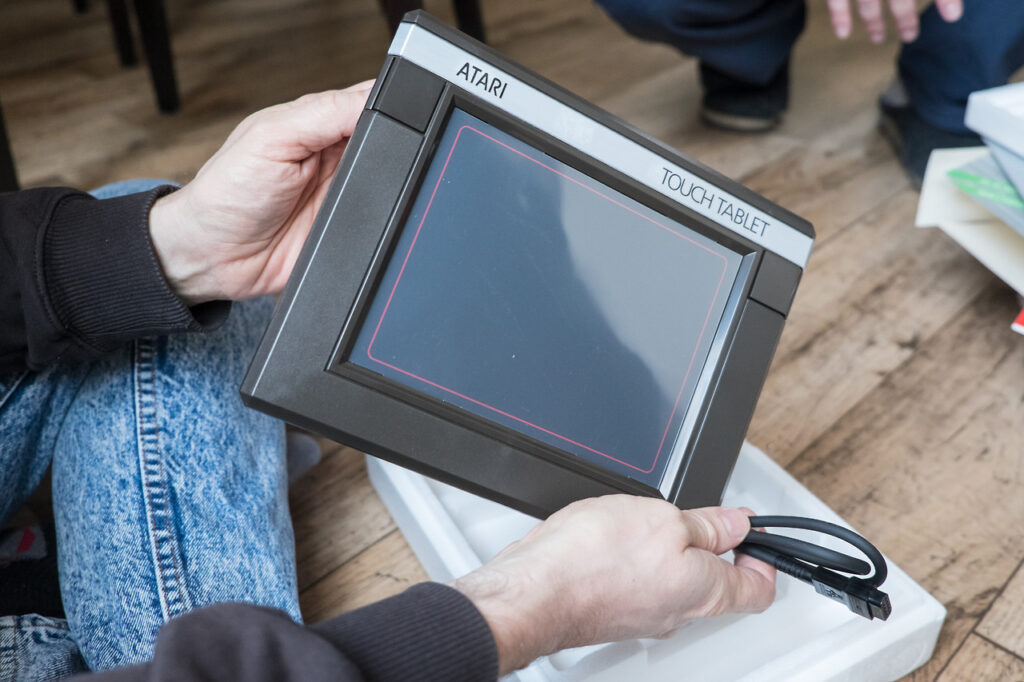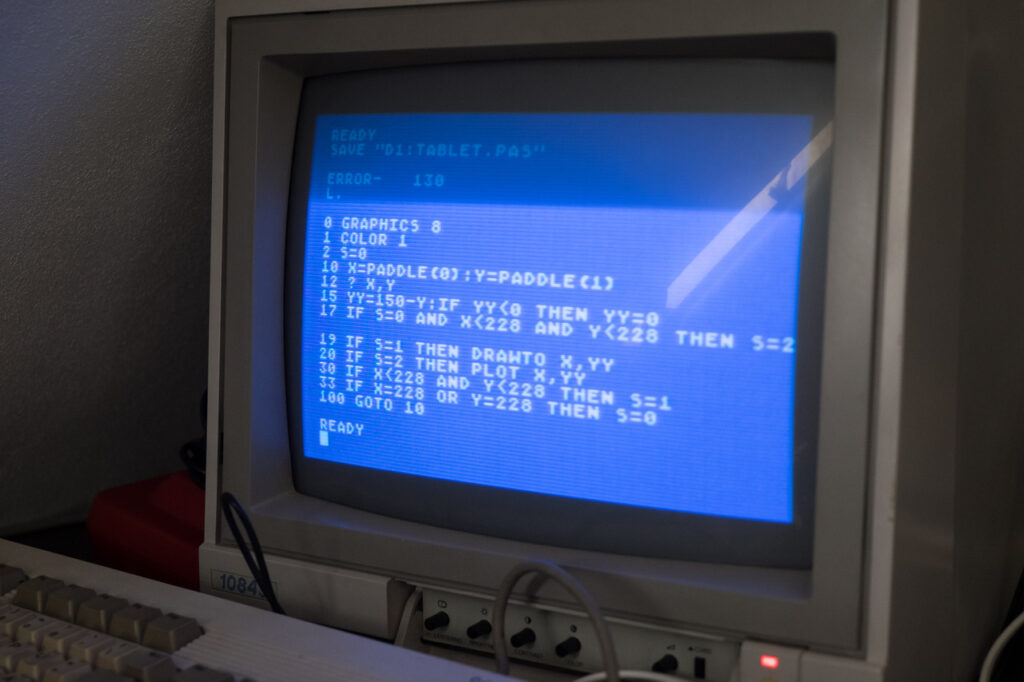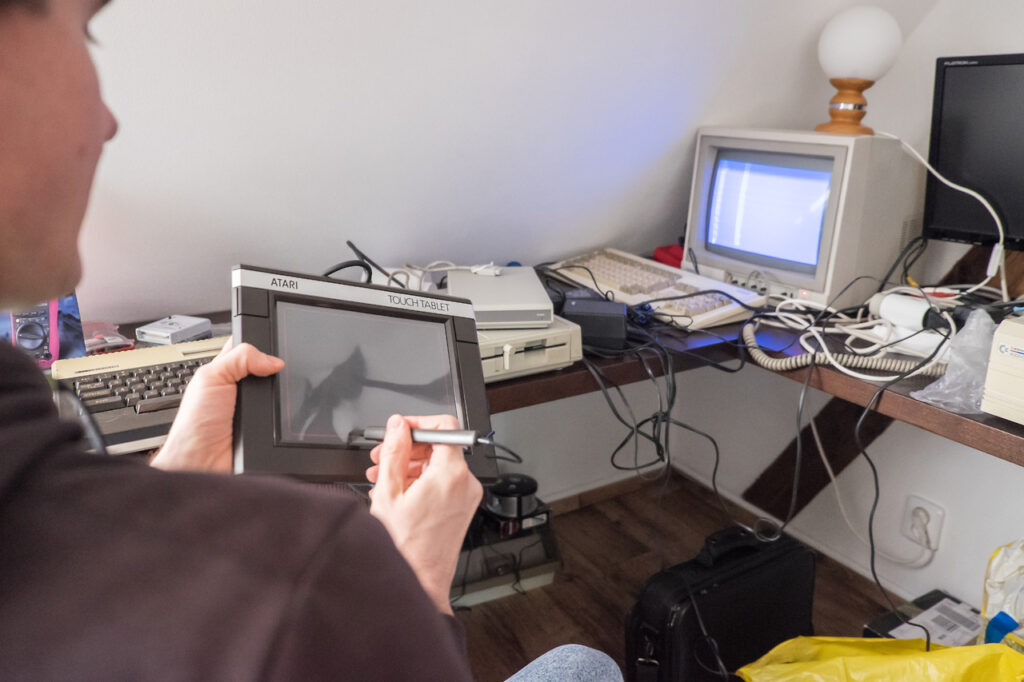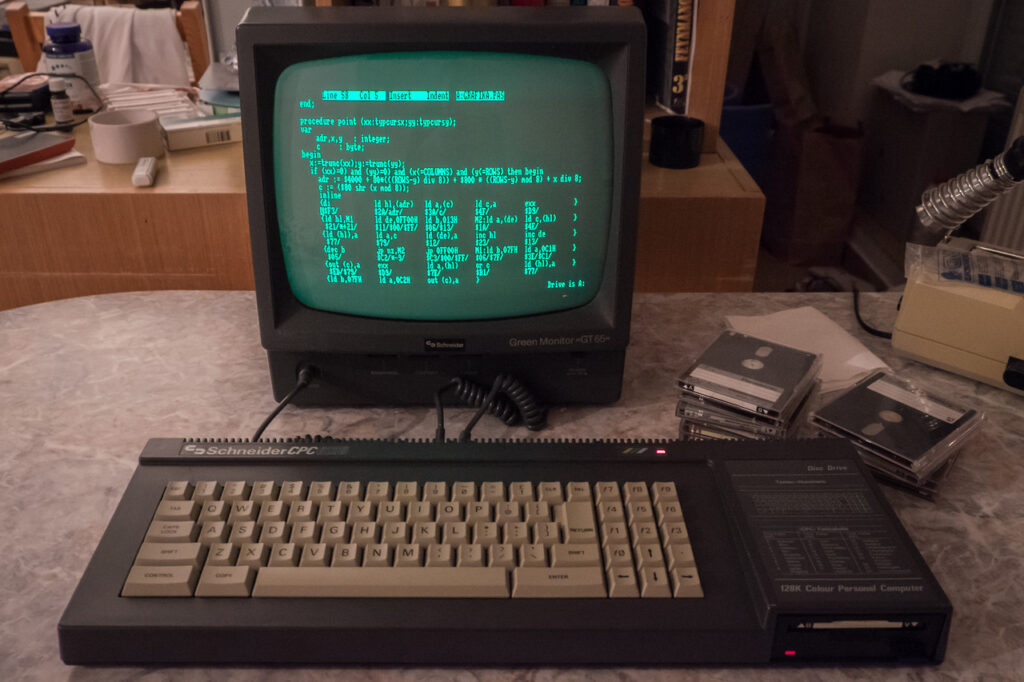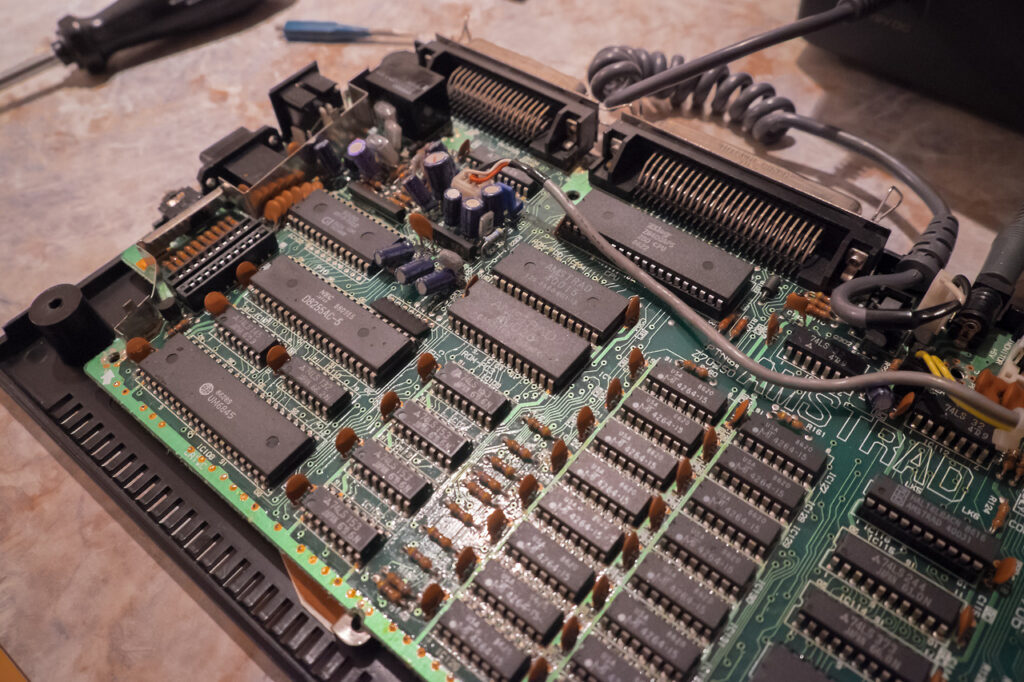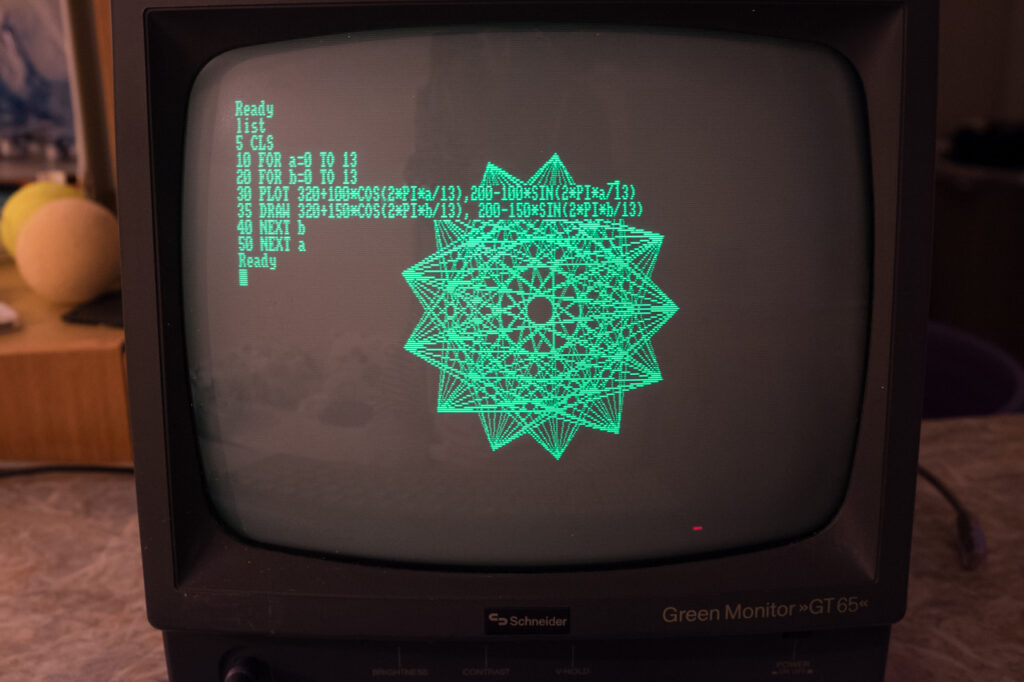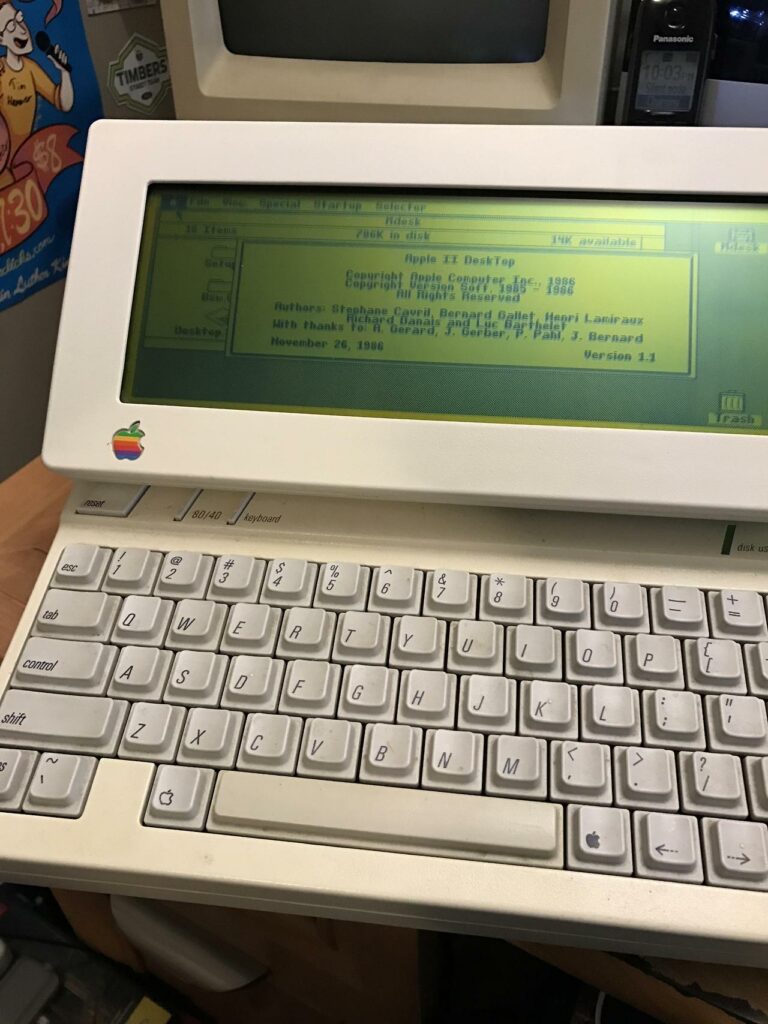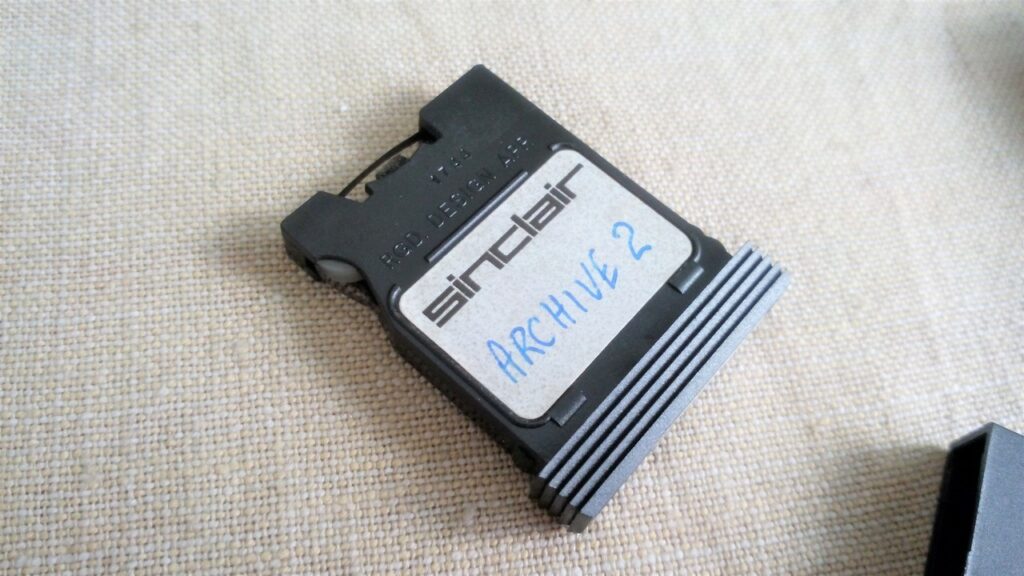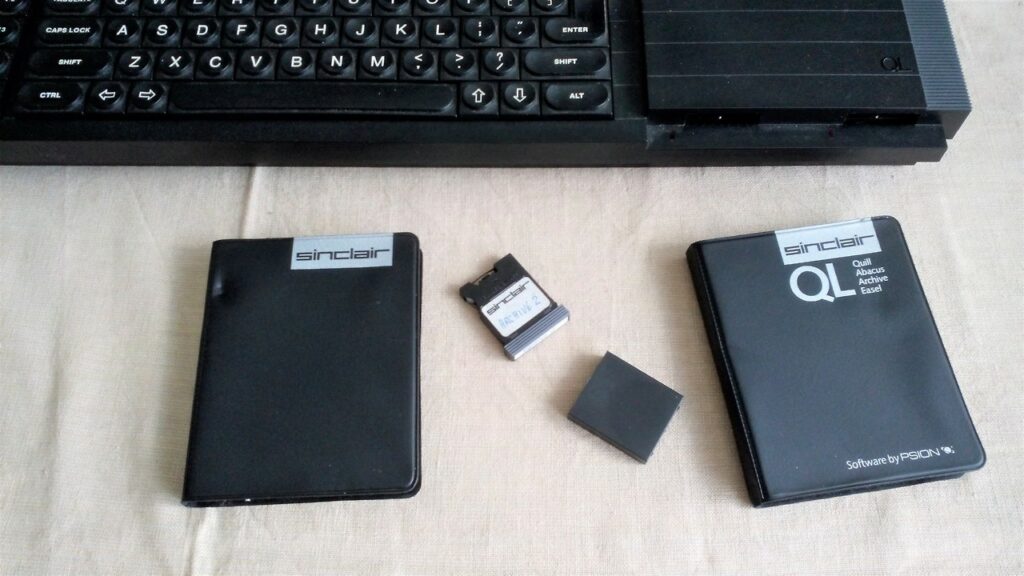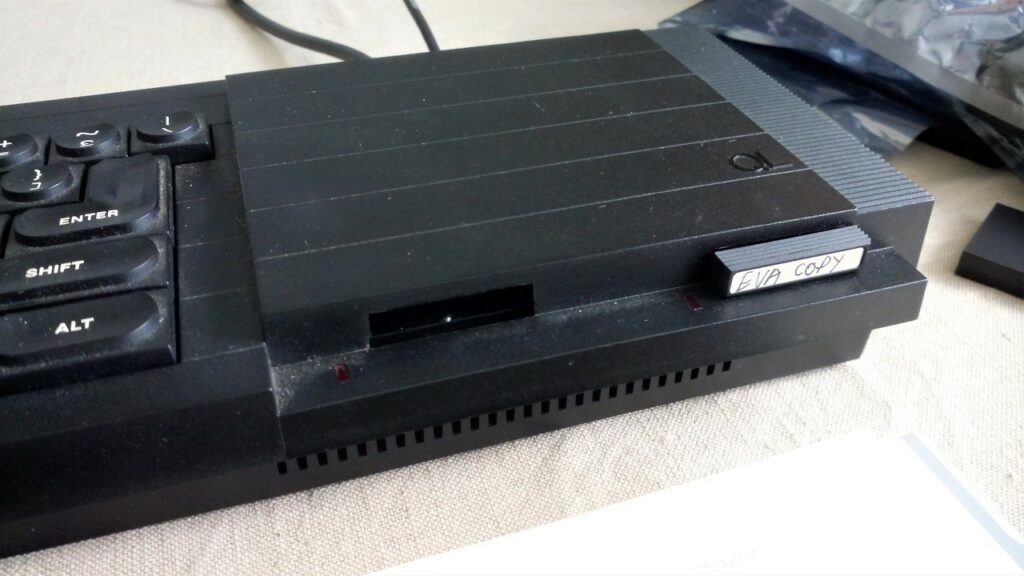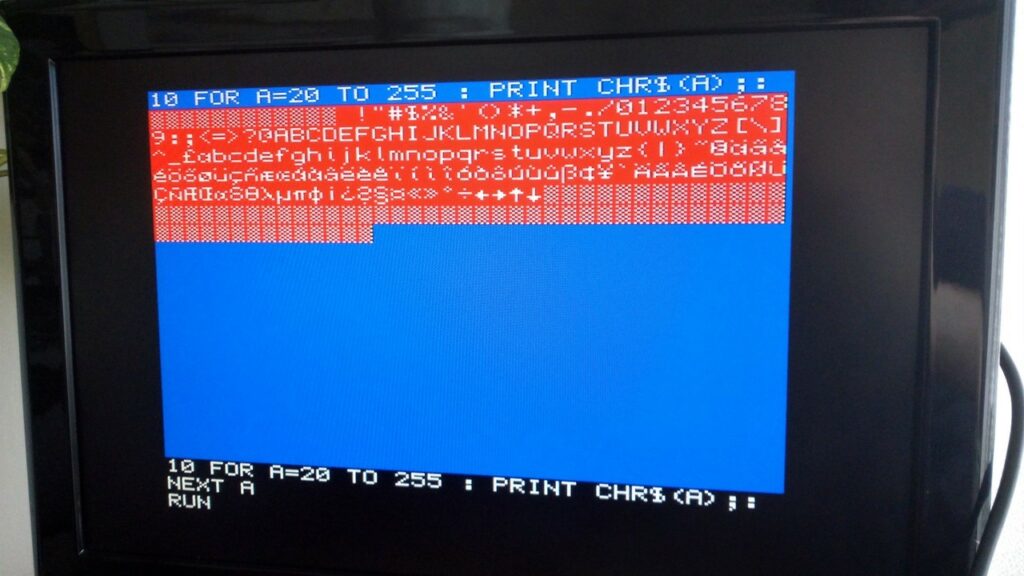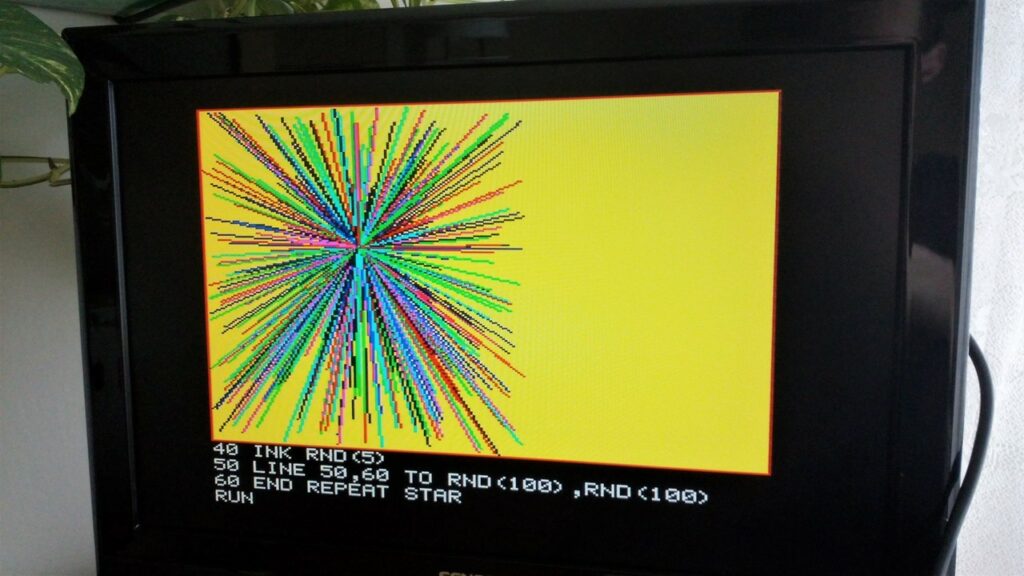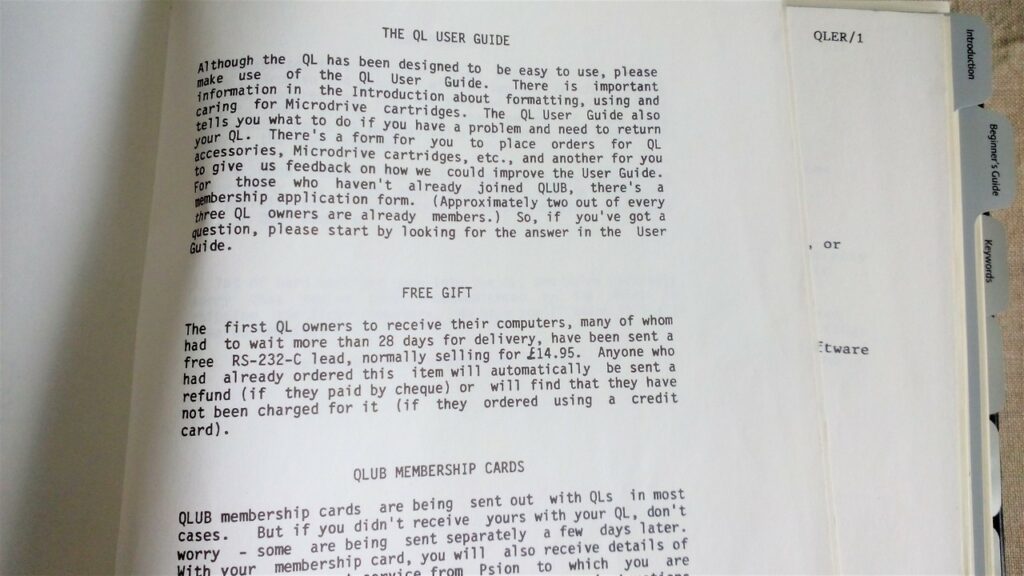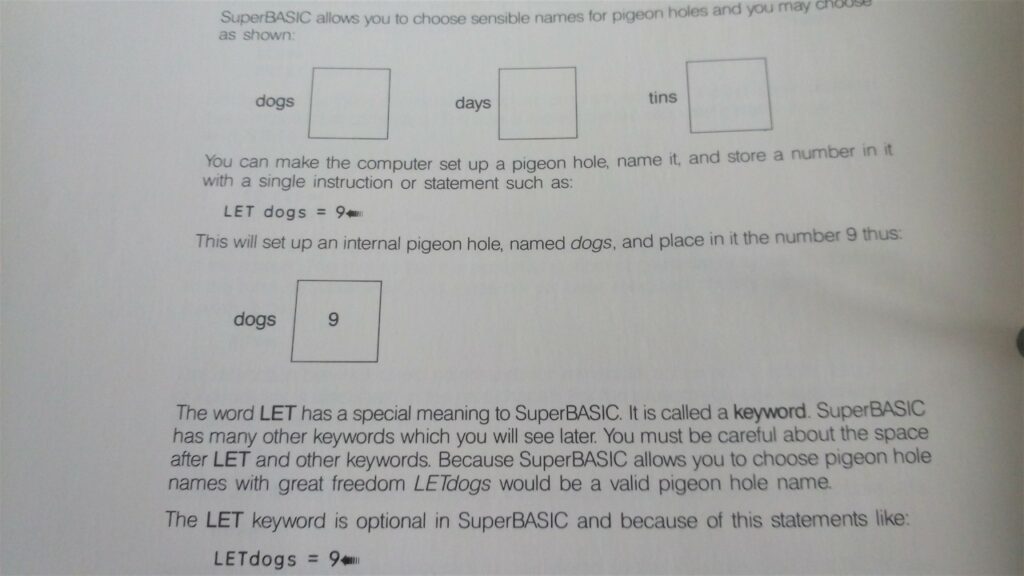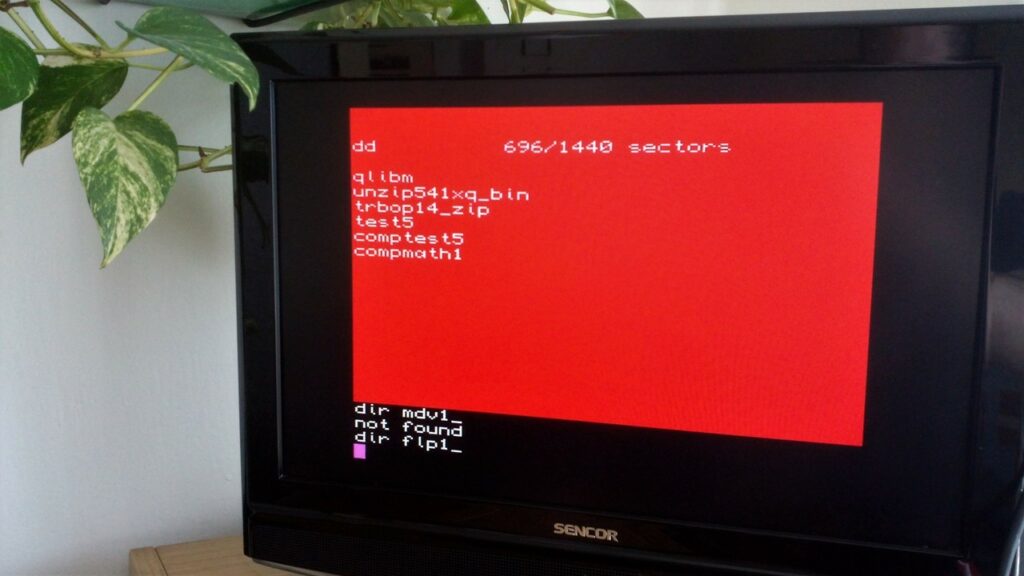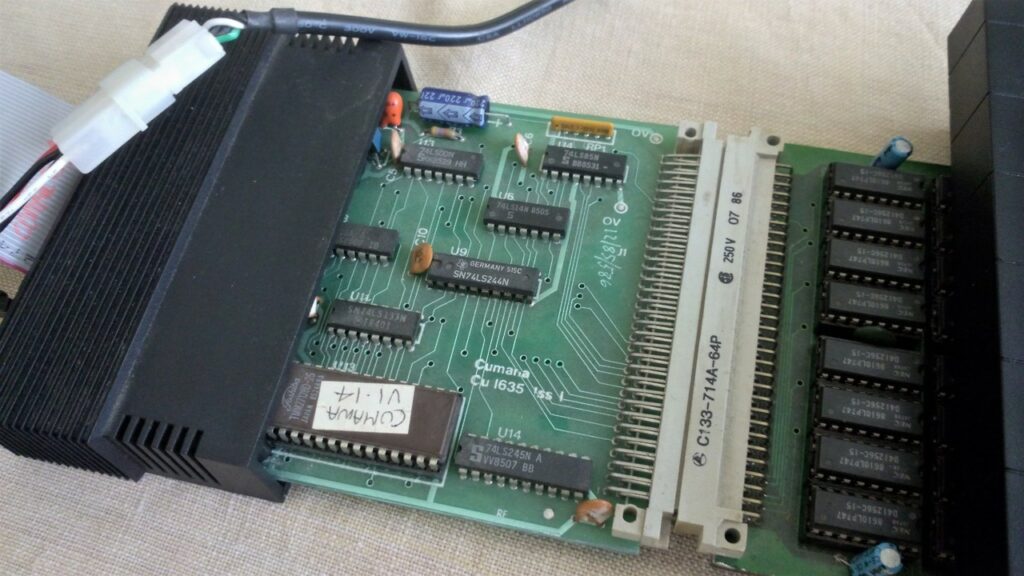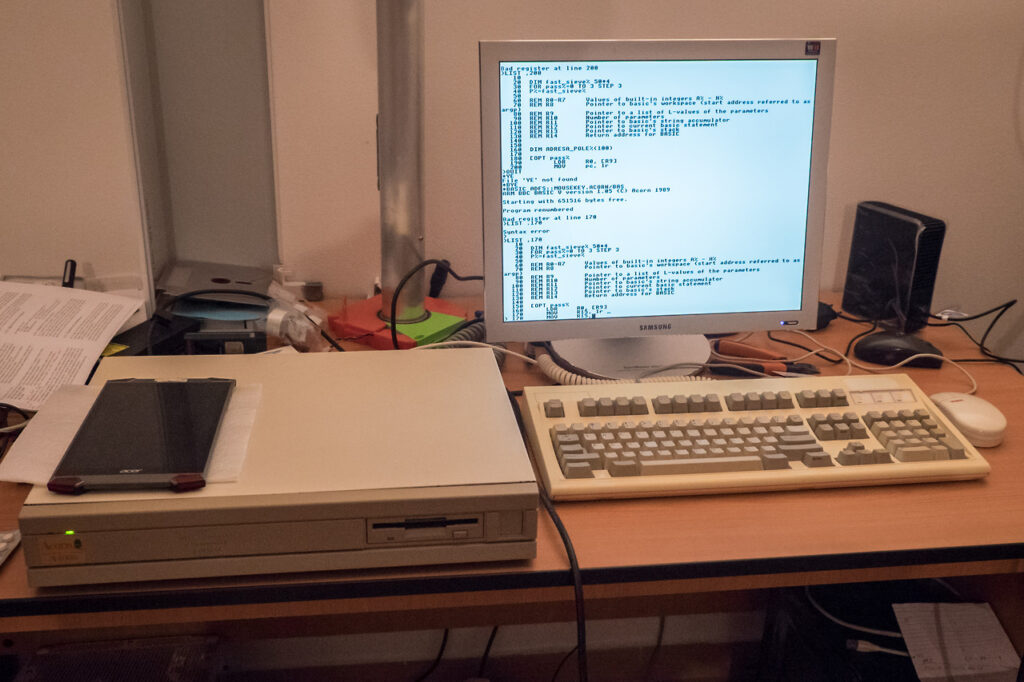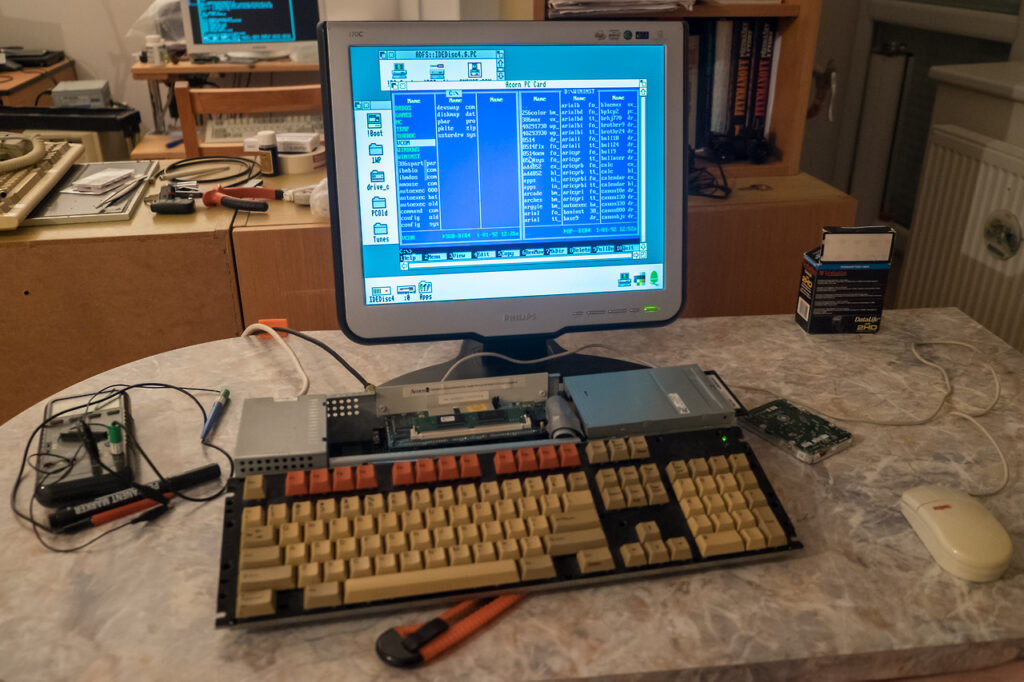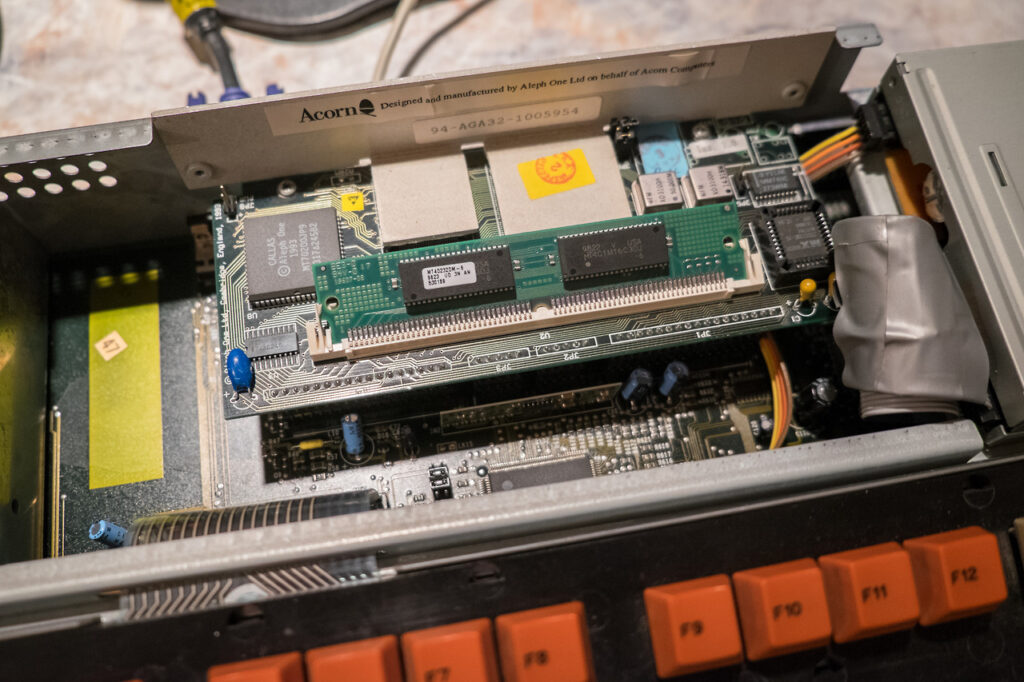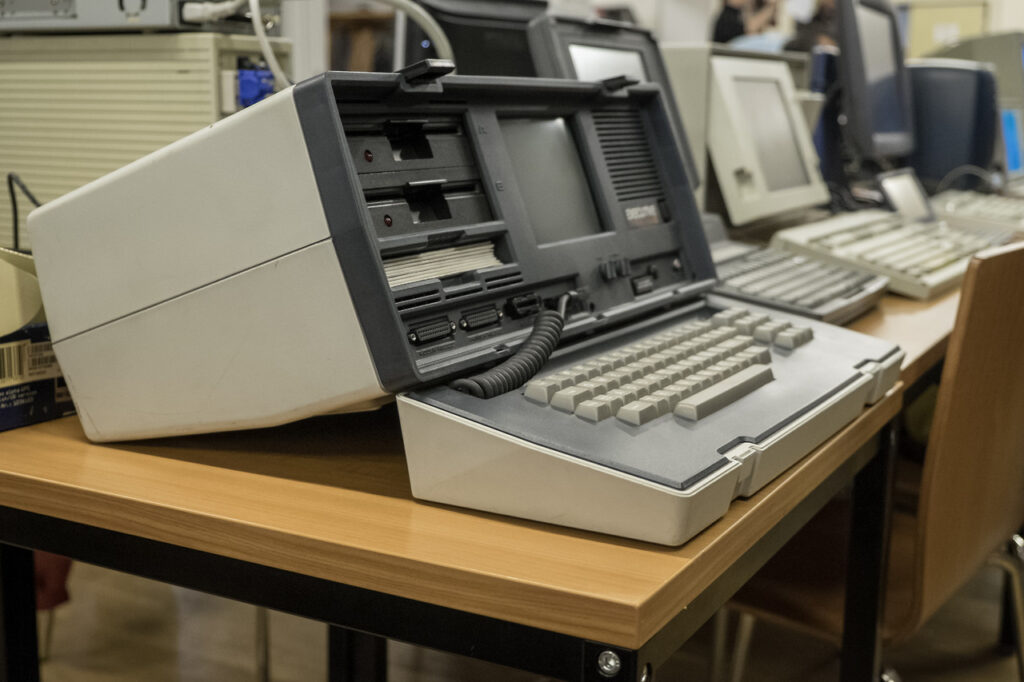vintage computer
Atari XEP80 (1987)
This device allowed users of Atari 8-bit computers to display full 80 characters per row on their screens. XEP80 came too late and used very strange way for connection with the computer – it was attached to a joystick port. It was quite slow with the original driver but there were 3rd-party drivers allowing users to double the screen update speed (matching 9600-baud serial terminals).
It’s a shame that Atari came with the device at the end of the 8-bit Atari series life and implemented it this way. The powerful terminal processor inside could do much more but that would need to connect it using the bus expansion connector. However, that connector changed over time on the 8-bit Atari series so that would affect compatibility. As a result there were not many software packages supporting its 80×24 mode.
Unfortunately, I didn’t have much time to play with the device. I only run bundled demo programs and took these photos (don’t be confused with the Commodore monitor and keyboard). I will definitely take it home one day and try how seriously this could be used back then.
SAPI-1 (1983)
On the left side, you can see SAPI-1 – a professional computer that was made in the Czechoslovak Socialist Republic and was used mainly for industrial applications. Its architecture was modular and not very far from S100-bus computers. One of the cards contained CPU (Zilog Z80 in this case) while other cards contained RAM, ROM and communication interfaces. It was able to run CP/M which was loaded from 8-inch floppy drives.
This photo is from the last Bytefest show a few weeks ago. We were copying files over a null-modem cable from Amstrad CPC6128. File transfers between different CP/M computers were not an easy task back in the 80s. Each computer had different floppy drives or at least a different logical format of the disks. This was very similar to terminal incompatibilities where every full-screen program had to support tens of terminals in order to be compatible with most CP/M computers. If your computer was not on the list, you ended up with incorrect layout of the text on the screen.
Because of these incompatibilities, serial and modem connections were the best ways to transfer files back then and they are even today. Don’t expect something “plug and play”. Although I could set the transfer speed in software on Amstrad CPC6128, the owner of the SAPI-1 had to remove the communication card and change the serial link configuration using a soldering gun. Another issue was to find programs with compatible transfer protocols but that’s a different story. Finally, after less than an hour, we were able to copy all our precious files.
Atari Touch Tablet (1984)
Atari Touch Tablet was a device compatible with 8-bit Atari computers and was intended for users who didn’t want to draw pictures with just joysticks or keyboards. We had not much time to test the device and an available heavily upgraded Atari computer didn’t work with the Atariartist cartridge. Therefore we tested it just using a simple BASIC program. It looked like the surface sensitivity degraded little bit over time but it was still usable.
I will post more once I have enough time to properly play with the device and supported software.
Amstrad (Schneider) CPC 6128
Although Amstrad CPC is not the preferred choice among vintage computer fans, it’s definitely a very interesting series of 8-bit computers and was sold in millions of units. This model combines 80-column display (screen resolution of 640×200), integrated 3-inch disk drive (each diskette can hold 360kB of data), AY sound and surprisingly good keyboard.
This was one of the cheapest computers that could run CP/M, the operating system with many professional programs available. Although Wikipedia says that there were a lot of games on CPC computers, I saw only people using this machine for actual work. This particular machine was used in the late 80s by a scientist in a geophysical institute for simulations and word processing. He sold the machine with an 5.25-inch external drive (made by Robotron and modified to work with CPC), an RS232c interface and a box full of disks containing development tools, his own Pascal programs and a customized version of WordStar (that allowed users to write and read Czech characters).
The keyboard is better that those on 8-bit Atari and Commodore computers and the computer gives more professional overall feeling. I like how CP/M has been integrated in the system. You can easily switch between BASIC (AMSDOS) and CP/M environments by using |CPM and AMSDOS commands and both use the same way to store files on disks.
I know that it is possible to run CP/M also on Spectrum +3 and Commodore 128. However, the former supports only 40-column display and the latter is significantly slower due to hardware design limits. This was a better choice for those who wanted to use CP/M on a home computer back then.
Apple IIc As a Battery-Powered Portable Computer
Apple IIc was designed to be portable. That meant that the computer could be easily carried from work to home or anywhere else where you had a power socket and a composite screen (or TV). I knew about the LCD option offered by Apple but I didn’t know that there were complete kits to make the computer usable everywhere.
A true mobile user could enhance his Apple IIc with a passive-matrix non-backlit LCD (connected to the video port using a ribbon cable) and an external lead acid battery. There were also bags specially designed to carry all this stuff safely.
This option was not very successful, though. Not because of its weight around five kilograms – that was adequate by the standards of the era (there were people carrying Osbornes). The main problem was the LCD screen which could produce a good picture only under direct sun light. The contrast was extremely low and the screen was hardly readable in a dimly lit room. I’ve tried few different laptop LCD screens from the same generation and my eyes almost bled after 30 minutes of work.
Having three separate parts was also not very convenient for frequent travelers. The screen was not designed to cover the keyboard when the computer was being transported and you always had to attach the battery. The first generation of laptops started to appear at the same time. Although they were as heavy as this kit, they had all components in a single briefcase-like package. In 1985, you could buy Bondwell Model 2 (a cheaper CP/M laptop with 64kB of memory) or one of those PC compatible laptops which started to appear at the end of the year (like my Bondwell Model 8).
Image sources: imgur.com, popcorn.cx
Sinclair QL, Motorola 68008 and Microdrive
A friend of mine sent me one Sinclair QL in a big box with manuals and accessories (ROM modules, floppy controller, IDE controller, 512k RAM expansion, RS232 adapter) because I wanted to test it using our benchmark and compare the results with 8088 in PC and Motorola 68000 in Amiga 500.
Sinclair equipped the computer with Motorola 68008. The standard 68000 CPU has a 16-bit data bus, but this smaller version has it only eight bits wide. The rest is the same so there are 32-bit CPU registers and 16-bit ALU. Using the narrowed data bus was an understandable way to make computers cheaper. IBM PC 5150/5160 has also its data bus eight bits wide. On the other side Intel 8088, unlike Motorola 68008, has a small prefetch queue so there should be smaller performance loss in comparison with a standard version of the chip.
I’ve never done anything with Sinclair QL so this is my first time. I’m quite surprised that the keyboard is mechanically much better than the one on Sinclair Spectrum+ (which looks almost the same). Also two integrated Microdrive units are easy to use and surprisingly fast. Each tape can hold 100kB of data and having two drives allows for easy tape copy.
X86 vs. ARM
We had a discussion about performance difference between IBM PS/2 with 20-MHz 386DX and Acorn A4000 with 12-MHz ARM in both Basic* and assembly code. David started to write code on A4000 and although I like the hardware, that British sense for user interface design would prevent me from being happy with this machine.
*) BBC Basic vs. MS QuickBasic
Acorn A3020 with a PC HW Emulator
It was common for many computer platforms to have a complete IBM PC compatible on a card in the 80s and early 90s. Software PC emulators were also a choice but their performance was usually very low. Having a card with a x86 CPU could solve the issue.
Acorn PC Card equipped with Cyrix 486SLC (25MHz) is almost as fast as Intel 486SX for certain tasks (main difference is in cache size: 1kB instead of 8kB) and the card allows you to get all the CPU performance. However if you expect full PC replacement, you would be very disappointed. The main limitation is in graphics performance. The card is usable only with text-mode programs and static graphics. Although VGA modes are emulated, even simple CGA games (like Alley Cat) are unplayable due to slow screen refresh. Good to mention that refresh speeds are somehow worse when PC Card output is changed from full-screen to windowed display.
I believe that it was better and probably not more expensive to buy a cheap PC clone instead of this card.
Osborne Executive (1983)
Portable devices of early 80s were intended only for strong people because carrying a 12-kg computer was definitely not for everyone. This “luggable” was equipped with 4-MHz Zilog Z80, ~120kB of RAM and two 5.25” floppy disk drives which made it a standard CP/M machine. It was cleverly designed with a sturdy case where all ports and vents were covered (this was not typical for its competitors). There were also cool features like an easy way to load a different character set and a fast video circuit with dedicated video RAM.
Although Osborne Executive can display 80 characters per row the CRT screen is so small that longer work is not very comfortable. I don’t like the screen much not only because of letters with size of few millimeters but also because I see heavy flickering. This is definitely not a long persistence screen. Fortunately, you can attach an external screen using (monochrome) composite video output which can work with both standards (software selectable) – PAL 50Hz and NTSC 60Hz (NTSC looks better because of higher refresh rate).
The keyboard provides good tactile feedback and with an external screen attached you have no-compromise CP/M compatible computer. I don’t see this very portable but there were different standards back then. It was nice to have a way to transport a computer in a single package.
Infoworld resources: Osborne Executive ad, “When Your Micro Becomes an Orphan”
